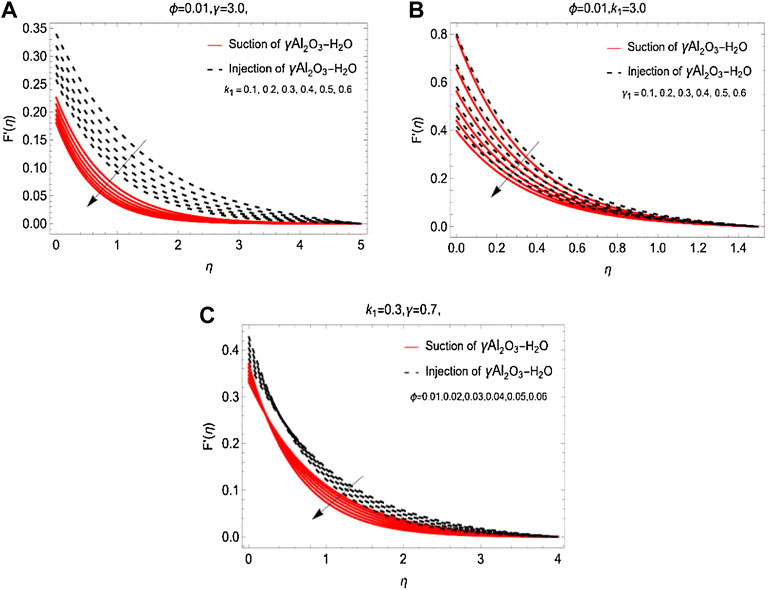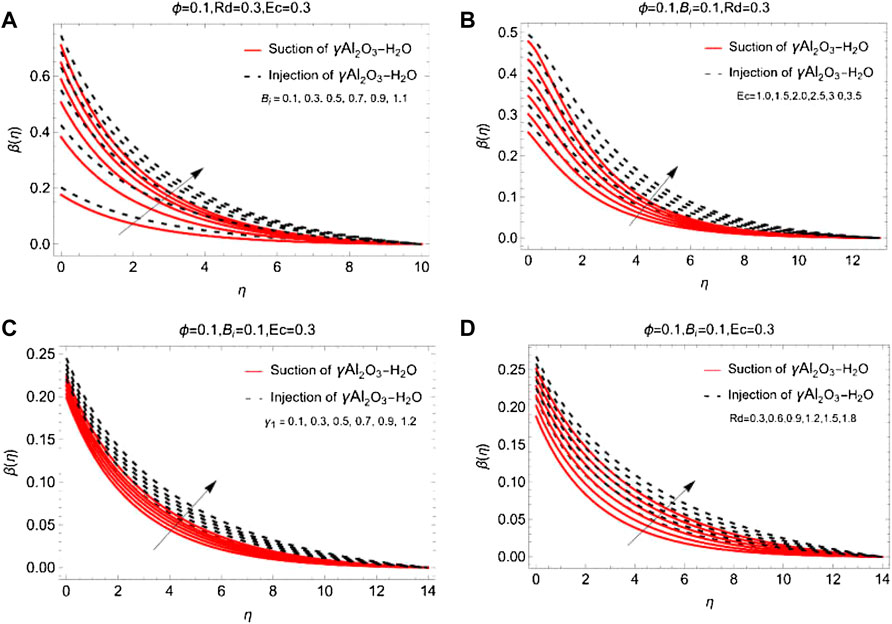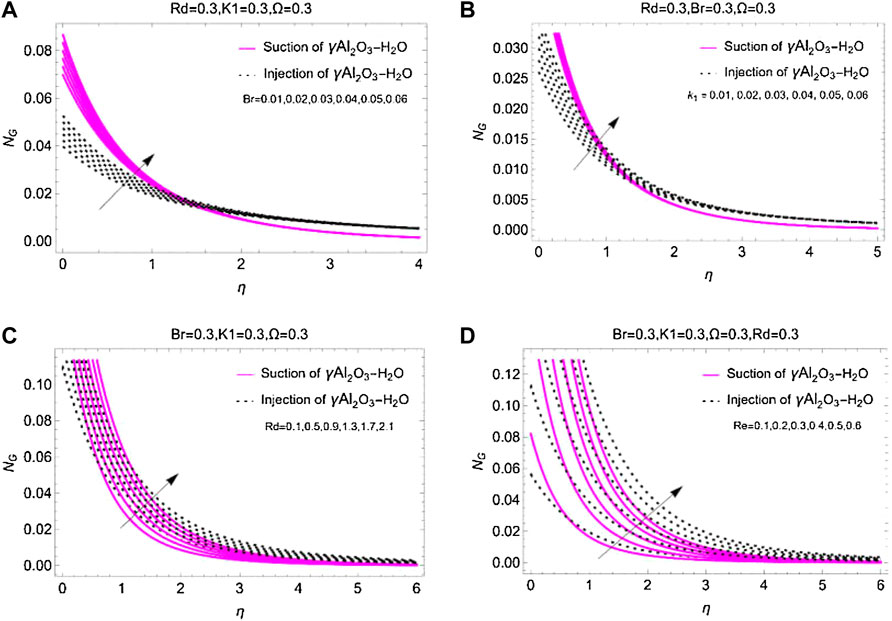- 1Department of Mathematics, Mohi-ud-Din Islamic University, Nerian Sharif AJ&K, Pakistan
- 2Department of Applied Mathematics and Statistics (AM&S), Institute of Space Technology (IST), Islamabad, Pakistan
- 3Department of Mathematics, COMSATS University Islamabad, Islamabad, Pakistan
- 4Department of Mathematics, College of Science Al-Zulfi, Majmaah University, Al-Majmaah, Saudi Arabia
- 5Electrical Engineering, Faculty of Engineering and Technology, Future University in Egypt, New Cairo, Egypt
- 6Department of Mechanical Engineering, College of Engineering at Al Kharj, Prince Sattam Bin Abdulaziz University, Al-Kharj, Saudi Arabia
- 7Department of Mechanical Engineering, University of Tunis EI Manar, ENIT, Tunis, Tunisia
The modern world moves toward new inventions by using nanotechnology and solar thermal radiations. On Earth, the Sun is the leading source of solar energy having a wider range of applications. These can be found in solar power plates (SPP), photovoltaic cells (PVC), solar thermal aircraft, and photovoltaic lighting. Therefore, the study is organized to analyze and improve the energy efficiency in the nanofluid over a permeable convective surface. The used nanofluid is synthesized by γ-nanoparticles and water. A theoretical experiment is conducted and a constitutive relation for the momentum and energy modeled. The model was tackled numerically and obtained the results for the velocity and energy transformation under varying effects of the pertinent flow parameters. From the study, it is observed that energy efficiency of the surface could be improved in the presence of solar thermal radiations, viscous dissipation, and convective heat conduction.
1 Introduction
The solar thermal radiations are the leading source of solar energy which has paramount importance in the modern technological world. It has wider applications in aerospace sciences, paint industries, electronics, and biomedical engineering. To enhance thermal energy, several conventional solar power plants were established. Although their prices and efficiencies are not human-friendly, yet, with the passage of time, these become more effective by inducing modern technologies in the solar plants regarding their thermal performance. The utilization of solar thermal radiation in the power plant industries remains a well-intentioned motive of the researchers and scientists. Execution of the power generation system and exergy analysis was reported by Wu et al. (2020). In 2021, Benhadji Serradj et al. (2021) discussed the design and performance of the parabolic trough collector plant. Utilization of the hybrid random vector for the optimized model was reported by Zayed et al. (2021).
The unrestricted approachability of solar thermal energy points innovative green technology appearance very talented concerning affordability, sustainability, protection, and spotless means of transportation. To build a solar aircraft that has much ability of energy storage through solar-powered aircraft technique contains photo-voltaic cells, rechargeable batteries, and a maximum power point tracker. These cells joined with trough of aircraft wing through which solar energy transforms into electrical energy and then is utilized to enhance the efficiency of the aircraft force system and avionics. A Swiss aeronaut, Bertrand Piccard, and a professional pilot, Andre Borschberg, significantly contributed to the development of solar aircraft. After their untiring efforts, finally they built fuel-less and environment-friendly aircraft consisting of a single seat. The major characteristic of the aircraft is solar energy playing the role of fuel for structured aircraft, due to which it is pollution free.
For said purpose, the aircraft is designed in such a way that photovoltaic cells adjusted under the craft wings act as the source of power for electric motors. Finally, the propellers in rotation gained mechanical energy produced by the motors and attained the desired kinetic energy. A historical perspective and future challenges in solar base airplanes were examined by Zhu et al. (2014). The study related to solar aircraft systems is discussed in the study by Abbe and Smith (2016). Furthermore, a comprehensive review for various methods to extract energy for solar aircraft was described by Gao et al. (2015). The flight efficiency of solar aircraft primarily depends on the power relevant to suitably choosing PV cells and weight. In order to achieve higher efficiency of solar aircraft, various technologies and materials have been examined. The aero dynamists are still working to improve the efficiency of solar aircraft by modifying PV cells. It is interesting to know that it utilized the Sun as an energy source in day-time and provided energy to the schemes at night-time. The schematic of the solar aircraft is depicted in Figure 1A.
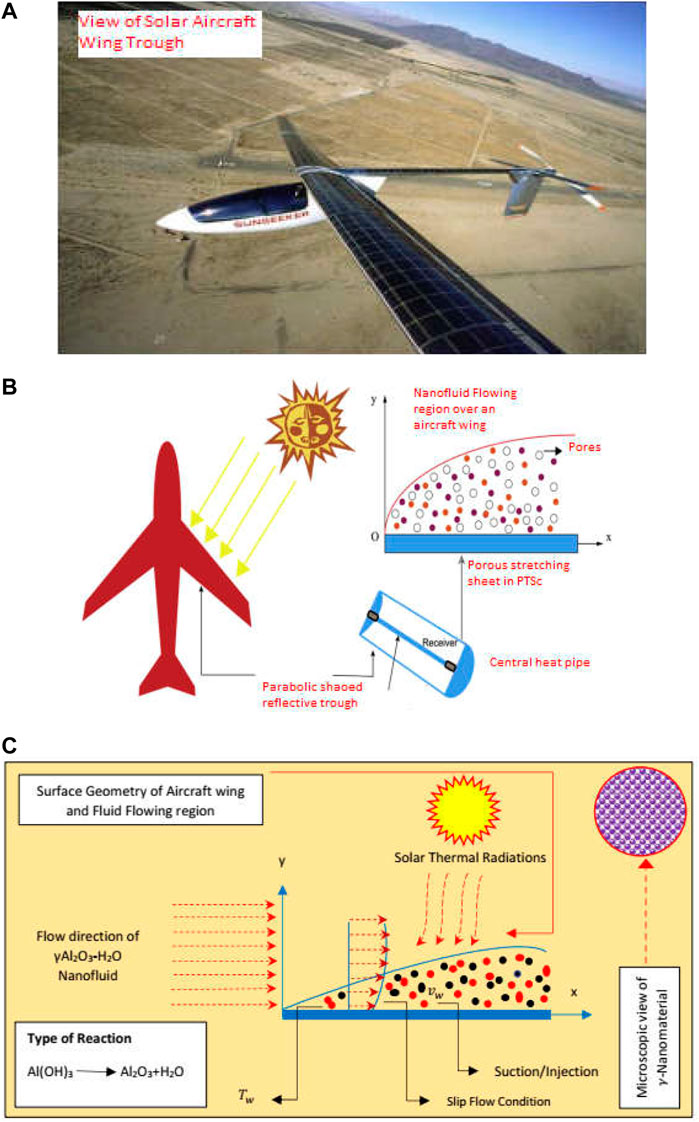
FIGURE 1. (A) Schematic of the solar aircraft. (B) Theoretical experimental setup for a surface. (C) Flow schematic of the nanofluid over a permeable surface.
In the designing of solar aircraft, parabolic trough solar collector (PTSC) is the most imperative skill; so far, they broadly used the other-directed solar power systems. Some imperative investigations of improved efficiency of solar aircraft associated with latest modern world technologies were described by Malan and Kumar (2021) and Goudarzi et al. (2020), respectively. In the organized study, our core concern will be the analysis of solar thermal efficiency of aircraft (STA). Thermal performance for the parabolic trough collector was explored in the study by Mwesigye and Yılmaz (2020). Another comparative investigation for three different solar aircraft was discussed in the study by Atiz (2020). An experimental study for parabolic collectors with direct flow was reported by Rezaeian et al. (2021).
Thermodynamics featuring in solar instruments can be improved effectively through nanoliquids coating. In which one of the significant ways is to induce nanofluid with functioning fluid due to which thermal performance of the device becomes progressive. Lately, researchers observed that the efficiency of solar refrigeration structure (SRS), solar devices (SDs), and water heater solar cells (WHSCs) may be upturned if the nanomaterials of high thermal conductance are utilized in the manufacturing of aforementioned modern devices. It was challenging to point out the nanomaterials that are most appropriate for these devices. The numerical and experimental inspection of nanofluids by taking two different base solvents (water and ethylene glycol) was discussed in the study by Kazem et al. (2021). The study of solar thermal systems by considering phase change material was reported by Ndukwu et al. (2021). A review of nanotechnology applications in solar thermal systems was done in the study by Alktranee and Bencs (2021). The used nanomaterials are of various metals and oxides composed by them like ZnO, Al2O3, SiO2, Fe, ND, Cu, and CuO. Despite this, there is another solid material commonly called carbon nanotubes (CNTs) (Bellos et al., 2018) which are further characterized as MWCNTs and SWCNTs, beneficial for thermal transport in SDs. These materials have very small diameter due to which these dissolved uniformly in regular liquids and enriched its thermal performance. The superior heat transport properties of nanoliquids strengthen their roots in various industries and are reported in the study by Zaharil (2021). The applications of nanotechnology under various circumstances for parabolic trough collectors are examined in the study by Ebrazeh and Sheikholeslami (2020).
The investigation of energy and entropy generation attracted researchers and scientists of the modern world. They thought that these features significantly alter due to the usage of new generation of regular liquids called nanoliquids. Earlier studies in this era were reported by Yejjer et al. (2017). The study of entropy for cylindrical pipes under the influence of nanofluids was deeply discussed by Ghanbarpour and Khodabandeh (2015). Recently, Shahzad et al. (2021) reported the dynamics of nanoliquids by Fe3O4 nanoparticles and found high thermal performance under certain flow conditions.
The influence of applied Lorentz forces on the flow behavior and heat transfer in the nanofluid in cavity was reported in by Benos and Sarris (2019). The dynamics of hybrid nanofluids (synthesized by aluminum and copper nanoparticles) with mixed convection and entropy analysis were examined by Li et al. (2021). Recently, Jamshed et al. (2021) explored the heat transfer inspection for second-grade fluid through a single phase model. Another imperative investigation of nanofluids’ thermal performance by inducing the KKL model in the constitutive relations was reported by Kumar et al. (2021). The study for the nanoliquid composed by nickel ferrite and manganese ferrite by taking water as a base solvent was described by Song et al. (2021).
This study is organized to improve the heat transfer over a permeable surface coated with nanoliquid dispersed by γ-nanomaterial. The influences of solar thermal radiations and viscous dissipation will be imposed over a convective. Then a mathematical nanofluid model will be attained and treated numerically. After that, for actual effects of aforesaid physical quantities on the energy efficiency and drag forces will be plotted within the feasible region and discussed deeply.
2 Theoretical Experiment and Flow Modeling
2.1 Theoretical Experimental Setup
In this subsection, a proposed theoretical experimental setup is organized for PSTCS coated with new generation of conventional liquids called nanoliquid. For energy efficiency of PSTCS, γAl2O3 nanoparticles, thermal radiations, and viscous dissipation are induced in the model of convective PSTCS. Another significant insight of drag forces on the wing of aircraft is also considered.
2.1.1 Motivational Aspects
▪ The shape of the aircraft wing imperatively alters the energy efficiency and drag forces, thus creating hindrance in the aircraft flight and resulting in energy loss. Therefore, PSTCS is used in the replacement of conventional PVC sheets.
▪ PSTCS has more energy storage capability because it is oriented in a cylindrical shape due to which its surface area is larger than conventional PVC.
▪ Solar aircraft make flight due to the storage of energy; hence, it is environment friendly and pollution free.
▪ The energy efficiency of PSTCS can be enhanced by coating its surface with new-generation fluids (nanofluids) diluted with γ-nanomaterial using thermal radiations, convective PSTCS, and viscous dissipation.
▪ Solar aircraft are human-friendly and economical due to their low manufacturing cost.
Figure 1B presents the setup of the theoretical experiment for PSTCS.
A schematic of the presence of imposed conditions, solar thermal radiations, and viscous dissipation is depicted in Figure 1C.
2.2 Nanofluid Flow Modeling
The mathematical modeling comprises the following information:
2.2.1 Empirical Nanofluid Correlations for γAl2O3/H2O
To improve the energy in the nanofluid, the following empirical correlations and their corresponding thermophysical values are utilized, and in the later stage, these will produce the flow model (Rashidi et al., 2016; Ahmed et al., 2017; Khan et al., 2017; Ahmed et al., 2018; Khan et al., 2020).
The thermophysical attributes of the used nanofluid are described in Table 1 (Benos and Sarris, 2019; AdnanKhan et al., 2021; Gkountas et al., 2021; Hamid et al., 2021; Madhukesh et al., 2021; AdnanKhan et al., 2022).
2.2.2 Constitutive Flow Model
It is presumed that the flow is incompressible and steady, and has some viscosity. Furthermore, a uniform interaction of the nanoparticles and the base solvent is taken. The nanoparticles and the host liquid are in thermal equilibrium and no slip effects occur between them. Thus, in view of boundary layer approximation theory (BLAT) and presumed assumptions, the following models are obtained.
2.2.2.1 Conservation of Mass and Momentum
2.2.2.2 Conservation of Energy
2.2.2.3 Imposed Conditions
The surface is subject to the following flow impositions:
The velocity components are taken as
2.2.2.4 Similarity Equations
The following streaming function and similarity equations are introduced for the transformation of the dimensional model into a non-dimensional version:
2.2.2.5 Final Version of the Model
By inducing the empirical correlations of the nanofluid, similarity equations, and impositions over the surface of the aircraft, the following version of the model is attained:
Subsequently, the new version of the imposed conditions is as follows:
2.2.2.6 Modeling of Drag Forces
The drag forces significantly interfere in the efficiency and speed of the solar aircraft. Therefore, it is important to analyze the behavior of the shear stresses against different parameters. The following dimensional expression supports the shear stresses:
With the help of shear stresses and nanoliquid empirical correlations, finally, the following version is attained:
3 Mathematical Analysis of the Model
To summarize the influences of various flow parameters, it is significant to analyze the corresponding mathematical model numerically. The modeled equations in engineering and other practical problems are coupled extremely nonlinearly on the bases of the flow scenario. The mathematical techniques based on approximate solutions are inadequate regarding the convergence due to which scientists and researchers prefer numerical treatment of the model. This technique is applicable when a higher-order system of ODEs is transformed into its subsystem of first-order ODEs. For this, a set of supporting transformations is required as below:
The model is then reduced in the following version:
The transformed model is then coded in MATHEMATICA 10.0 and the graphical results furnished.
4 Results With Discussion
4.1 The Velocity Field
This subsection is devoted to analyzing the velocity over the surface against various flow parameters furnished in Figure 2.
The porosity effects on the velocity over a surface are presented in Figure 2A for both suction/injection of the fluid. The velocity drops significantly due to pores over the surface. Physically, more fluid particles drag to fill the pores due to which the frictional force becomes dominant and ultimately the motion declines. The prompt decrement is noticeable due to a lot of pores being present there, and, gradually, the motion decreases at ambient location. For the suction case, the fluid decreases abruptly because maximum fluid particles move over the surface to fill the space due to pores. For injecting fluid, the fluid moves quite rapidly over the surface.
Figures 2B,C show the fluid motion against slip effects
4.2 Thermal Distribution
Thermal behavior against extra convection (Biot number) from the surface is elaborated in Figure 3A. It is observed that the surface is heated convectively, and then a significant increase in the temperature occurs. Due to stronger effects at the surface, maximum rise in the temperature is noticed. Physically, the temperature of particles in the locality of the surface gain energy from the surface via conduction, and after that, these particles transfer energy to the rest of the particles via convection, which affects the wing temperature.
The effect of viscous dissipation, slip parameter, and solar thermal radiation on temperature is plotted in Figures 3B–D, respectively. From these, it is evident that energy storage could be enhanced in the presence of Ec, slip effects, and solar thermal radiations, which is ultimately beneficial for the aircraft. Furthermore, injection of the fluid significantly alters the thermal behavior.
4.3 Entropy Generation
Entropy optimization analysis in the light of varying flow quantities attained much interest from researchers and mechanical engineers. Therefore, this subsection is designed to observe the entropy behavior against
4.4 Thermophysical Featuring of Empirical Correlations
Thermophysical values of the colloidal suspensions are key ingredients for thermal enhancement in the nanofluids. The trends in effective thermophysical values against the fraction factor are plotted in Figure 5. From the results, it is observed that effective density, thermal conductivity, and dynamic viscosity increase with the increase in the fraction factor. These are elaborated by Figures 5A–C. However, heat capacity drops by enhancing the nanomaterial fraction factor (Figure 5D).
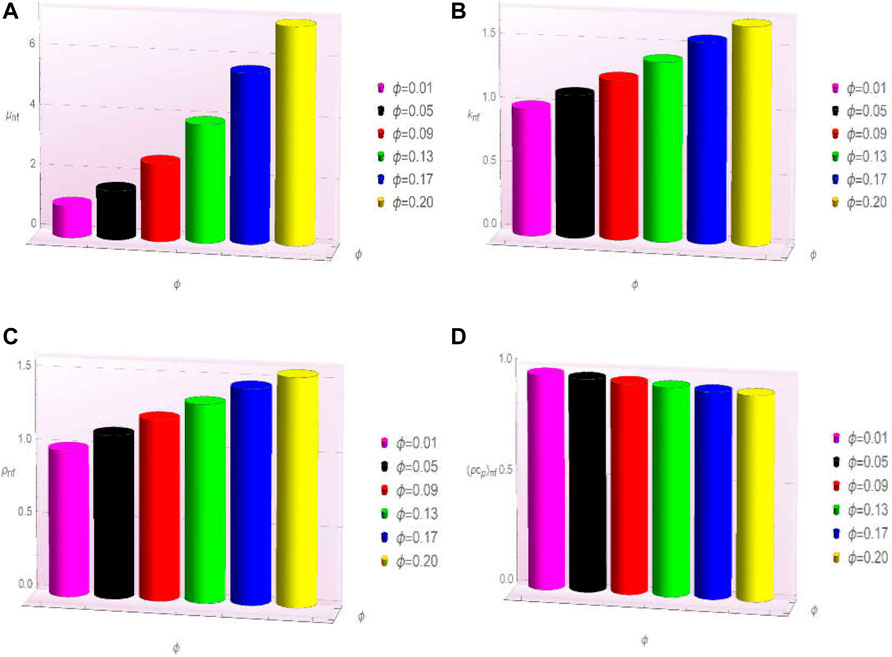
FIGURE 5. Thermophysical featuring of the nanofluid for varying
4.5 Trends of Drag Forces
Shear drag forces over the surface are of great significance to enhance the efficiency of the aircraft during its flight. It is observed that the drag forces decrease prominently over the surface due to porosity. These results are presented in Figures 6A,B.
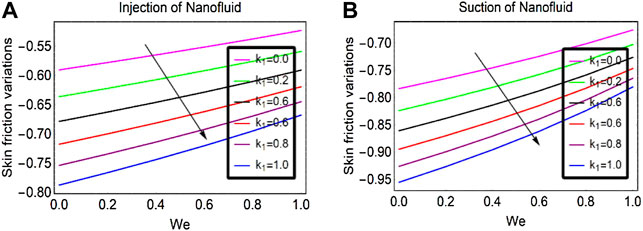
FIGURE 6. Trends in the shear stresses in the nanofluid for varying (A) k1 injection and (B) k1 suction.
5 Concluding Remarks
This analysis concerns the heat transport inspection in
5.1 Future Perspectives
In future, the model could be extended for various types of nanolubricants and nanofluids by incorporating nonlinear thermal radiations, convective heat condition, second-order slip, and Joule heating effects. All these studies would be helpful in tackling problems related to heat transfer.
Data Availability Statement
The numerical study is conducted and the data is given within the article. The raw data supporting the conclusion of this article will be made available by the authors, without undue reservation.
Author Contributions
A and WA wrote the original draft. A and HJ performed the mathematical analysis. A and WA wrote the results and discussion. MM and SM revised the manuscript; rectified the grammatical mistakes and corrected; A, WA and IK validated the code.
Conflict of Interest
The authors declare that the research was conducted in the absence of any commercial or financial relationships that could be construed as a potential conflict of interest.
Publisher’s Note
All claims expressed in this article are solely those of the authors and do not necessarily represent those of their affiliated organizations, or those of the publisher, the editors, and the reviewers. Any product that may be evaluated in this article, or claim that may be made by its manufacturer, is not guaranteed or endorsed by the publisher.
References
Abbe, G., and Smith, H. (2016). Technological Development Trends in Solar‐powered Aircraft Systems. Renew. Sustain. Energ. Rev. 60, 770–783. doi:10.1016/j.rser.2016.01.053
AdnanKhan, U., Ashraf, W., Khan, U., Al-Johani, A. S., Ahmed, N., Mohyud-Din, S. T., et al. (2022). Impact of Freezing Temperature (Tfr) of Al2O3 and Molecular Diameter (H2O)d on thermal Enhancement in Magnetized and Radiative Nanofluid with Mixed Convection. Sci. Rep. 12. doi:10.1038/s41598-021-04587-9
AdnanKhan, U., Khan, U., Ahmed, N., and Mohyud-Din, S. T. (2021). Enhanced Heat Transfer in H2O Inspired by Al2O3 and γAl2O3 Nanomaterials and Effective Nanofluid Models. Adv. Mech. Eng. 13 (5), 168781402110236. doi:10.1177/16878140211023604
Ahmed, N., Adnan, , Khan, U., and Mohyud-Din, S. T. (2018). A Theoretical Investigation of Unsteady Thermally Stratified Flow ofγAl2O3−H2OandγAl2O3−C2H6O2nanofluids through a Thin Slit. J. Phys. Chem. Sol. 119, 296–308. doi:10.1016/j.jpcs.2018.01.046
Ahmed, N., Khan, U. U., and Mohyud-Din, S. T. (2017). Influence of an Effective Prandtl Number Model on Squeezed Flow of γAl2 O3 -H2 O and γAl2 O3 -C2 H6 O2 Nanofluids. J. Mol. Liquids 238, 447–454. doi:10.1016/j.molliq.2017.05.049
Alktranee, M., and Bencs, P. (2021). Applications of Nanotechnology with Hybrid Photovoltaic/Thermal Systems. Jaes 19, 1–15. doi:10.5937/jaes0-28760
Atiz, A. (2020). Comparison of Three Different Solar Collectors Integrated with Geothermal Source for Electricity and Hydrogen Production. Int. J. Hydrogen Energ. 45 (56), 31651–31666. doi:10.1016/j.ijhydene.2020.08.236
Bellos, E., Said, Z., and Tzivanidis, C. (2018). The Use of Nanofluids in Solar Concentrating Technologies: A Comprehensive Review. J. Clean. Prod. 196, 84–99. doi:10.1016/j.jclepro.2018.06.048
Benhadji Serradj, D. E., Sebitosi, A. B., and Fadlallah, S. O. (2021). Design and Performance Analysis of a Parabolic Trough Power Plant under the Climatological Conditions of Tamanrasset, Algeria. Int. J. Environ. Sci. Technol. 19, 3359–3376. doi:10.1007/s13762-021-03350-x
Benos, L., and Sarris, I. E. (2019). Analytical Study of the Magnetohydrodynamic Natural Convection of a Nanofluid Filled Horizontal Shallow Cavity with Internal Heat Generation. Int. J. Heat Mass Transfer 130, 862–873. doi:10.1016/j.ijheatmasstransfer.2018.11.004
Ebrazeh, S., and Sheikholeslami, M. (2020). Applications of Nanomaterial for Parabolic Trough Collector. Powder Technol. 375, 472–492. doi:10.1016/j.powtec.2020.08.005
Gao, X.-Z., Hou, Z.-X., Guo, Z., and Chen, X.-Q. (2015). Reviews of Methods to Extract and Store Energy for Solar-Powered Aircraft. Renew. Sustain. Energ. Rev. 44, 96–108. doi:10.1016/j.rser.2014.11.025
Ghanbarpour, M., and Khodabandeh, R. (2015). Entropy Generation Analysis of Cylindrical Heat Pipe Using Nanofluid. Thermochim. Acta 610, 37–46. doi:10.1016/j.tca.2015.04.028
Gkountas, A. A., Benos, L. T., Sofiadis, G. N., and Sarris, I. E. (2021). A Printed-Circuit Heat Exchanger Consideration by Exploiting an Al2O3-Water Nanofluid: Effect of the Nanoparticles Interfacial Layer on Heat Transfer. Therm. Sci. Eng. Prog. 22, 100818. doi:10.1016/j.tsep.2020.100818
Goudarzi, S., Shekaramiz, M., Omidvar, A., Golab, E., Karimipour, A., and Karimipour, A. (2020). Nanoparticles Migration Due to Thermophoresis and Brownian Motion and its Impact on Ag-MgO/Water Hybrid Nanofluid Natural Convection. Powder Technol. 375, 493–503. doi:10.1016/j.powtec.2020.07.115
Hamid, A., Naveen Kumar, R., Punith Gowda, R. J., Varun Kumar, R. S., Khan, S. U., Ijaz Khan, M., et al. (2021). Impact of Hall Current and Homogenous-Heterogenous Reactions on MHD Flow of GO-MoS2/water (H2O)-Ethylene Glycol (C2H6O2) Hybrid Nanofluid Past a Vertical Stretching Surface. Waves in Random and Complex Media, 1–18. doi:10.1080/17455030.2021.1985746
Jamshed, W., Nisar, K. S., Gowda, R. J. P., Kumar, R. N., and Prasannakumara, B. C. (2021). Radiative Heat Transfer of Second Grade Nanofluid Flow Past a Porous Flat Surface: a Single-phase Mathematical Model. Physica Scripta 96, 064006. doi:10.1088/1402-4896/abf57d
Kazem, H. A., Al-Waeli, A. H. A., Chaichan, M. T., and Sopian, K. (2021). Numerical and Experimental Evaluation of Nanofluids Based Photovoltaic/thermal Systems in Oman: Using Silicone-Carbide Nanoparticles with Water-Ethylene Glycol Mixture. Case Stud. Therm. Eng. 26, 101009. doi:10.1016/j.csite.2021.101009
Khan, U., Adnan, , Ahmed, N., and Mohyud-Din, S. T. (2020). Surface thermal Investigation in Water Functionalized Al2O3 and γAl2O3 Nanomaterials-Based Nanofluid over a Sensor Surface. Appl. Nanosci. doi:10.1007/s13204-020-01527-3
Khan, U., Ahmed, N. N., and Mohyud-Din, S. T. (2017). 3D Squeezed Flow of γAl2O3-H2O and γAl2O3-C2H6O2 Nanofluids: A Numerical Study. Int. J. Hydrogen Energ. 42, 24620–24633. doi:10.1016/j.ijhydene.2017.07.090
Kumar, R. N., Suresha, S., Gowda, R. J. P., Megalamani, S. B., and Prasannakumara, B. C. (2021). Exploring the Impact of Magnetic Dipole on the Radiative Nanofluid Flow over a Stretching Sheet by Means of KKL Model. Pramana 95, 180. doi:10.1007/s12043-021-02212-y
Li, Y.-X., Khan, M. I., Gowda, R. J. P., Ali, A., Farooq, S., Chu, Y.-M., et al. (2021). Dynamics of Aluminum Oxide and Copper Hybrid Nanofluid in Nonlinear Mixed Marangoni Convective Flow with Entropy Generation: Applications to Renewable Energy. Chin. J. Phys. 73, 275–287. doi:10.1016/j.cjph.2021.06.004
Madhukesh, J. K., Kumar, R. N., Gowda, R. J. P., Prasannakumara, B. C., Ramesh, G. K., Khan, M. I., et al. (2021). Numerical Simulation of AA7072-AA7075/water-Based Hybrid Nanofluid Flow over a Curved Stretching Sheet with Newtonian Heating: A Non-fourier Heat Flux Model Approach. J. Mol. Liquids 335, 116103. doi:10.1016/j.molliq.2021.116103
Malan, A., and Kumar, K. R. (2021). A Comprehensive Review on Optical Analysis of Parabolic Trough Solar Collector. Sustainable Energ. Tech. Assessments 46, 101305.
Mwesigye, A., and Yılmaz, I. H. (2020). Thermal and Thermodynamic Benchmarking of Liquid Heat Transfer Fluids in a High Concentration Ratio Parabolic Trough Solar Collector System. J. Mol. Liquids 319, 114151. doi:10.1016/j.molliq.2020.114151
Ndukwu, M. C., Bennamoun, L., and Simo-Tagne, M. (2021). Reviewing the Exergy Analysis of Solar Thermal Systems Integrated with Phase Change Materials. Energies 14, 724. doi:10.3390/en14030724
Rashidi, M. M., Vishnu Ganesh, N., Abdul Hakeem, A. K., Ganga, B., and Lorenzini, G. (2016). Influences of an Effective Prandtl Number Model on Nano Boundary Layer Flow of γ Al2O3–H2O and γ Al2O3–C2H6O2 over a Vertical Stretching Sheet. Int. J. Heat Mass Transfer 98, 616–623. doi:10.1016/j.ijheatmasstransfer.2016.03.006
Rezaeian, M., Shafiey Dehaj, M., Zamani Mohiabadi, M., Salarmofrad, M., and Shamsi, S. (2021). Experimental Investigation into a Parabolic Solar Collector with Direct Flow Evacuated Tube. Appl. Therm. Eng. 189, 116608. doi:10.1016/j.applthermaleng.2021.116608
Shahzad, F., Jamshed, W., Sajid, T., Nisar, K. S., and Eid, M. R. (2021). Heat Transfer Analysis of MHD Rotating Flow of Fe3O4 Nanoparticles through a Stretchable Surface. Commun. Theor. Phys. 73, 075004. doi:10.1088/1572-9494/abf8a1
Song, Y.-Q., Khan, M. I., Qayyum, S., Gowda, R. J. P., Kumar, R. N., Prasannakumara, B. C., et al. (2021). Physical Impact of Thermo-Diffusion and Diffusion-Thermo on Marangoni Convective Flow of Hybrid Nanofluid (MnZiFe2O4-NiZnFe2O4-H2o) with Nonlinear Heat Source/sink and Radiative Heat Flux. Mod. Phys. Lett. B 35, 2141006–2141022. doi:10.1142/S0217984921410062
Wu, J., Han, Y., and Hou, H. (2020). A New Solar Share Evaluation Method of Solar Aided Power Generation (SAPG) System by Tracing Exergy Flows and Allocating Exergy Destruction. Solar Energy 198, 542–554. doi:10.1016/j.solener.2020.01.059
Yejjer, O., Kolsi, L., Aich, W., Al-Rashed, A. A. A. A., Borjini, M. N., and Ben Aissia, H. (2017). Study of Three-Dimensional Natural Convection and Entropy Generation in an Inclined Solar Collector Equipped with Partitions. Heat Trans. Asian Res. 46, 1312–1326. doi:10.1002/htj.21275
Zaharil, H. A. (2021). An Investigation on the Usage of Different Supercritical Fluids in Parabolic Trough Solar Collector. Renew. Energ. 168, 676–691. doi:10.1016/j.renene.2020.12.090
Zayed, M. E., Zhao, J., Li, W., Elsheikh, A. H., Elaziz, M. A., Yousri, D., et al. (2021). Predicting the Performance of Solar Dish Stirling Power Plant Using a Hybrid Random Vector Functional Link/chimp Optimization Model. Solar Energy 222, 1–17. doi:10.1016/j.solener.2021.03.087
Zhu, X., Guo, Z., and Hou, Z. (2014). Solar-powered Airplanes: A Historical Perspective and Future Challenges. Prog. Aerospace Sci. 71, 36–53. doi:10.1016/j.paerosci.2014.06.003
Nomenclature
Pr Prandtl number
Rd Thermal radiation parameter
Ec Eckert number
S Suction/inject parameter
Keywords: γAl2O3 nanoparticles, solar thermal radiations, convective heat condition, numerical analysis, viscous dissipation
Citation: Adnan , Ashraf W, Junaid Anjum H, Khan I, Mousa M and Mehrez S (2022) Energy Transformation and Entropy Investigation in the Nanofluid Composed by γ-Nanomaterial Over a Permeable Convective Surface With Solar Thermal Radiation: A Numerical Analysis. Front. Energy Res. 10:888389. doi: 10.3389/fenrg.2022.888389
Received: 02 March 2022; Accepted: 06 April 2022;
Published: 10 May 2022.
Edited by:
Hsien-Yi (Sam) Hsu, City University of Hong Kong, Hong Kong SAR, ChinaReviewed by:
Gireesha B. J., Kuvempu University, IndiaIskander Tlili, King Saud University, Saudi Arabia
Copyright © 2022 Adnan, Ashraf, Junaid Anjum, Khan, Mousa and Mehrez. This is an open-access article distributed under the terms of the Creative Commons Attribution License (CC BY). The use, distribution or reproduction in other forums is permitted, provided the original author(s) and the copyright owner(s) are credited and that the original publication in this journal is cited, in accordance with accepted academic practice. No use, distribution or reproduction is permitted which does not comply with these terms.
*Correspondence: Adnan, adnan_abbasi89@yahoo.com
 Adnan
Adnan Waqas Ashraf2
Waqas Ashraf2 Ilyas Khan
Ilyas Khan
